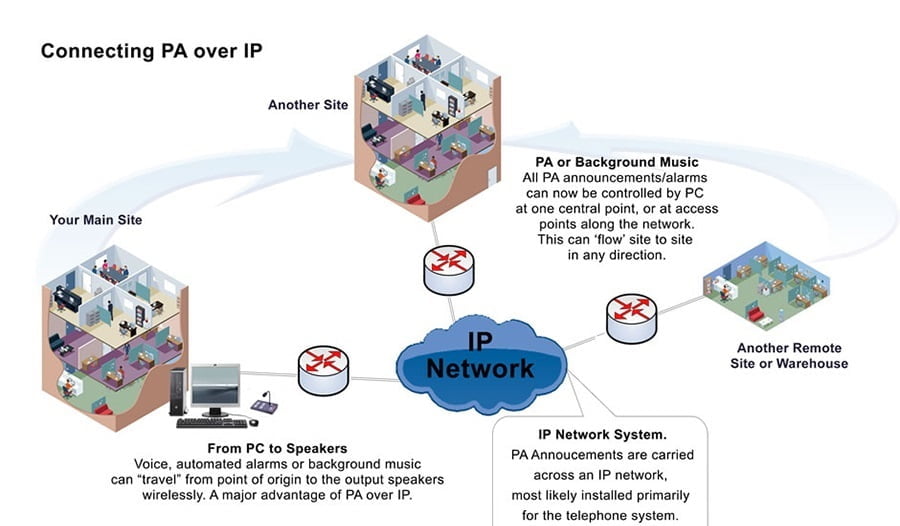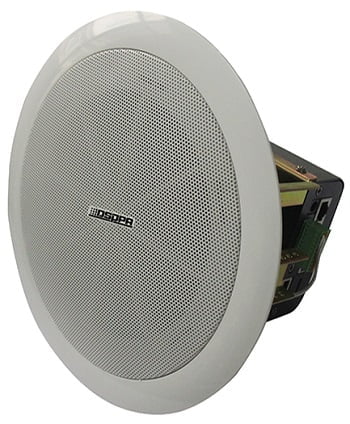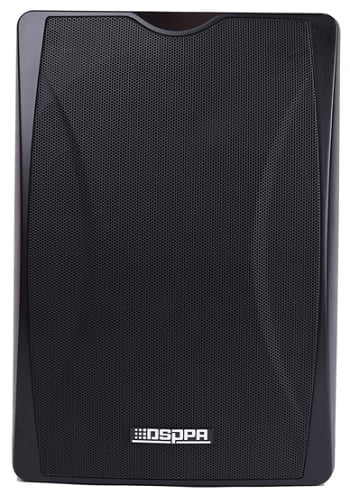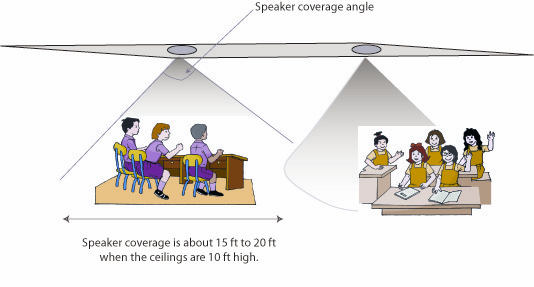Buyers Guide: Selecting the Right Speakers for IP PA System
A public address system (PA system) is an electronic system comprising microphones, amplifiers, loudspeakers, and related equipment. It increases the apparent volume (loudness) of a human voice, musical instrument, or other acoustic sound source or recorded sound or music. PA systems are used in any public venue that requires that an announcer, performer, etc. be sufficiently audible at a distance or over a large area. Typical applications include sports stadiums, public transportation vehicles and facilities, and live or recorded music venues and events. A PA system may include multiple microphones or other sound sources, a mixing console to combine and modify multiple sources, and multiple amplifiers and loudspeakers for louder volume or wider distribution.

One of the most important components in a paging system is the speakers. So before we define any paging system, we start by determining the amount of sound required at each location. Once we know the type of sound required, we can select the right speaker. After we have defined the speakers, we can determine the right amplifier to use.

What’s the best speaker for you? Well it depends on a number of things. For example, do you want to hear music or just voice paging? The type of speaker also depends on how large an area you want to cover with sound. The background noise and where you want to place the speaker is also important. It may be necessary to select a different speaker for each location. This article reviews how to select the right speaker for the job. We will review the sound output which is measured in decibels (dB), the sound quality (or frequency range), and the power required at the speaker.
Types of Speakers
There are many types of speakers available such as ceiling speakers, wall speakers, and horns. They are also available with direct (8-ohm) or transformer type (25 V or 70 V) inputs. You can only connect up to four 8-ohm speakers to one of the 8-ohm outputs of an amplifier. A 70-volt speaker system has a transformer inside each speaker, as well as a single transformer at the output of the amplifier. You can daisy-chain many 70-volt speakers to a single 7-volt amplifier output. For example, you can attach about eight 70-volt speakers to a single 70-volt amplifier, with 20-watt  power output. The IP7-SS20 is an example of a 20-watt, network attached IP amplifier. The more speakers you attach the lower the power available to each speaker, and thus the lower the maximum sound output level from each speaker.
power output. The IP7-SS20 is an example of a 20-watt, network attached IP amplifier. The more speakers you attach the lower the power available to each speaker, and thus the lower the maximum sound output level from each speaker.
Power and Sound Output
Speakers are rated at a specific sound level (measured in dB), at a specific power level (1 Watt), and at a specific distance away from the speaker (1M). DB or decibel is the measure of sound level output. A Watt is the electric power that comes from the amplifier. For example, 60dB is the sound level of normal conversation. 120dB is the sound of amplified rock concert, and by the way experts recommend using earphones when the sound level is continuously over 85dB. The rule of thumb is that every time we double the power, we get an additional 3dB of sound out. So if we select a speaker that has a specification of 94 dB @ 1W/1M, and we double the power to 2 watts, we increase the sound level to 97dB, and if we double the power again (4 watts), we get another 3dB or 100dB of sound.

Sound Level and Distance from Speaker
The further away you are from the speaker the less sound you hear. The sound level goes down 6dB every time we double the distance from the speaker. For example, a speaker that provides 118 dB of sound at 1M will have a sound level of 112 dB at 2 M from the speaker. At 4 m (13 ft.), the sound is 106 dB; at 8 m (26 ft.), it’s 100dB; at 16 m (52.5 ft.); and at 32 m (105 ft.), it’s 96dB, etc. Just for your reference, 96 dB is the sound of a power mower. So you can see that this speaker and amplifier would provide enough sound to allow children playing in a large yard, to hear an announcement.
Sound Coverage
Speakers are also rated by the angle of coverage. The coverage is measured in angle. If you are directly in front of the speaker it will sound much louder than if you are off to the side. For example, the DSPPA IP network mounts on the wall and it can best be heard at an angle within 115 degrees. If the speaker is mounted on the ceiling, you would like to select one that has as wide a coverage area as possible.

Sound Quality or Frequency response
Just like your home stereo system, the wider the frequency range of the speaker the better the sound quality will be. The specifications will tell you the range of frequency response for the speaker. If you are playing music, you want a frequency range that’s as wide as possible. Better speakers will cost more, so you have to first determine what you want to hear. For example, the DSPPA ceiling speaker has a very good frequency response of 60 to 20,000 Hz so it’s great for both music and voice paging. Other speakers have frequency ranges of 300 Hz to 15 KHz, which is just fine for listening to a person talking.
Where they are placed
There are a variety of speakers available, some mount in drop ceilings, others go on the walls. There are those you can use outdoors and others that are only used indoors. As we discussed the sound level changes the further away you are and the further off centered you are form the speaker. If you place a speaker in the ceiling it will sound very good when you are close to it. The higher the ceiling the more dispersion you will get. So if you have a room with 10 ft. ceilings you may be able to hear the speaker when you are about 5 ft. off center, but if you have a ceiling that’s 20 ft. tall you can be 10 ft. away from the center of the speaker.
 Conclusion:
Conclusion:
The best speaker for your IP paging system depends on where and how you want to use it. You can select the right speaker by looking at the speaker specifications. It describes the power required to achieve a specific sound level. It also shows the frequency response and angle of sound dispersal. You may also select the speaker for the ease of installation or even how it looks.
If you need help selecting the right speaker, just contact us at 01973432325, 01973432326, 01973432328, 01973432342
